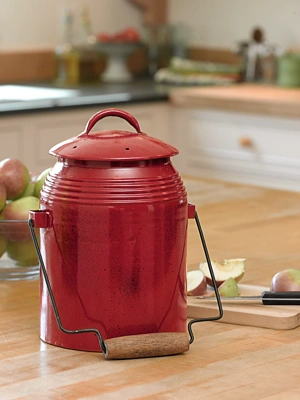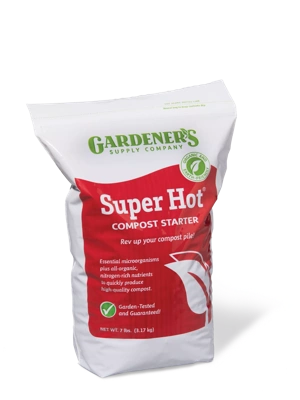Compost Troubleshooting Tips
How to Keep Your Compost Cooking
 If your compost isn't cooking, review these tips to get things going again:
If your compost isn't cooking, review these tips to get things going again:
- Compost pile won't heat up The materials may be too dry. This can happen quickly during the summer months. Try to keep your compost materials moist to the touch. Cover the pile. Another possibility is that the pile may be low in nitrogen. Fast-working microorganisms can quickly consume all the nitrogen and leave undecomposed carbon materials behind. Replenish the nitrogen content of your pile with fresh green grass clippings, garden weeds, kitchen scraps, manure, or an activator, such as SuperHot Compost Starter. Another possible cause: Your pile is too small. Collect more materials and mix everything into a pile that measures 3 feet on each side, and is at least 3-feet high.
- Soggy CompostDense or water-logged compost piles don't contain enough oxygen for the microorganisms to survive. Often these piles give off an unpleasant odor. The solution is to aerate the pile and add more dry materials.
- Smelly CompostIf your pile smells like ammonia, it may contain too much nitrogen. Add carbon materials such as straw, leaves, or hay to correct the balance.
- Finished product is too coarse.Some materials, such as eggshells and corncobs, take a long time to break down. If you want finely textured compost, shred or chop the materials before putting them into the bin. You can also sift out large chunks and throw them back into the next pile.
Composting Tips
- Keep a stash of straw, kitty litter, dry leaves, or peat moss near your compost pile. Sprinkle a little on the top of the pile each time you add fresh weeds or kitchen scraps. These high-carbon materials will help keep the C/N ratio in balance.
- Try burying your kitchen scraps right in the garden. Just dig a 12- to 15-inch-deep hole in the pathway, pour in the scraps, and cover with soil.
- Hunt around your town for a plentiful source of free organic material. You might try a horse farm, food processing plant, local wood shop, or grounds maintenance service.
- Cover your pile for best results. It will deter pests, hold in heat, and keep the moisture level more constant. A pile that's dry or too water-logged takes a very long time to break down. You can use a tarp, piece of plastic, hunk of old carpet, or piece of metal roofing.
- In northern states, cover your pile in late fall to avoid leaching nutrients and to prevent the pile from becoming water-logged. A drier pile will thaw more quickly the following spring.
- Don't add compost to a seed-starting mix unless you are sure that the pile got hot enough to be sterilized (140 to 160 degrees F). Seedlings are very susceptible to bacteria that are harmless to more mature plants.
- Shredded materials compost very rapidly. The more surface area for microbes to attack, the sooner you'll have usable compost. You can chop your materials with a machete or shovel, run them through a shredding machine, or run over them with your lawn mower.
- Compost piles that are smaller than 3 feet by 3 feet will have trouble heating up - especially in cool climates. Piles larger than 5 feet by 5 feet may not allow enough air to reach the center.
- If fruit flies are a problem indoors, your compost container is probably not airtight. Make sure it has a tight-fitting lid that gets sealed shut after being opened.
- If skunks and burrowing rodents are hanging around your compost pile, try using a powdered or spray repellent . You can also bury hardware cloth up and around the bottom of your compost bin. Avoid putting meat or fatty foods in your pile: they attract all sorts of animals.
Last updated: 07/17/2023
Print this Article:
Related items
Get the Dirt
Stay up to date on new articles and advice. Please fill out the information below.











